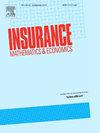Co-opetition in reinsurance markets: When Pareto meets Stackelberg and Nash
IF 2.2
2区 经济学
Q2 ECONOMICS
引用次数: 0
Abstract
We develop and solve a two-layer game to model co-opetition, a strategic combination of competition and cooperation, in a reinsurance market consisting of one primary insurer and two reinsurers, in which all players are equipped with mean-variance preferences and the reinsurance contracts are priced under the variance premium principle. The insurer negotiates reinsurance contracts with the two reinsurers simultaneously, modeled by two Stackelberg games, and the two reinsurers compete for business from the same insurer by setting their own pricing rules, modeled by a non-cooperative Nash game. The combined Stackelberg-Nash game constitutes the first layer of the game model and endogenously determines the risk assumed by each reinsurer. The two reinsurers, then, participate in a cooperative risk-sharing game, forming the second layer of the game model, and seek Pareto-optimal risk-sharing rules. We obtain equilibrium strategies in closed form for both layers. The equilibrium of the Stackelberg-Nash game consists of two proportional reinsurance contracts, with the more risk-averse reinsurer assuming a smaller portion of the insurer's total risk. The Pareto-optimal risk-sharing rules further dictate that the more risk-averse reinsurer transfers a portion of its assumed risk to the less risk-averse reinsurer, at the cost of a positive side payment.
再保险市场的合作竞争:当帕累托与Stackelberg和Nash相遇时
在一个原保险人和两个再保险公司组成的再保险市场中,所有参与者都具有均值-方差偏好,再保险合同在方差保费原则下定价,本文建立并求解了一个两层博弈模型,以模拟竞争与合作的战略结合——合作竞争。保险公司与两家再保险公司同时协商再保险合同,采用两个Stackelberg博弈模型,两家再保险公司通过制定自己的定价规则来争夺同一家保险公司的业务,采用非合作纳什博弈模型。组合的Stackelberg-Nash博弈构成了博弈模型的第一层,它内生地决定了每个再保险人所承担的风险。然后,两家再保险公司参与合作风险共担博弈,形成博弈模型的第二层,寻求帕累托最优风险共担规则。我们得到了两层的封闭均衡策略。Stackelberg-Nash博弈的均衡由两个比例再保险合同组成,其中风险厌恶程度越高的再保险公司承担的总风险比例越小。帕累托最优风险分担规则进一步规定,风险厌恶程度越高的再保险人将其承担的部分风险转移给风险厌恶程度越低的再保险人,代价是正面支付。
本文章由计算机程序翻译,如有差异,请以英文原文为准。
求助全文
约1分钟内获得全文
求助全文
来源期刊

Insurance Mathematics & Economics
管理科学-数学跨学科应用
CiteScore
3.40
自引率
15.80%
发文量
90
审稿时长
17.3 weeks
期刊介绍:
Insurance: Mathematics and Economics publishes leading research spanning all fields of actuarial science research. It appears six times per year and is the largest journal in actuarial science research around the world.
Insurance: Mathematics and Economics is an international academic journal that aims to strengthen the communication between individuals and groups who develop and apply research results in actuarial science. The journal feels a particular obligation to facilitate closer cooperation between those who conduct research in insurance mathematics and quantitative insurance economics, and practicing actuaries who are interested in the implementation of the results. To this purpose, Insurance: Mathematics and Economics publishes high-quality articles of broad international interest, concerned with either the theory of insurance mathematics and quantitative insurance economics or the inventive application of it, including empirical or experimental results. Articles that combine several of these aspects are particularly considered.
 求助内容:
求助内容: 应助结果提醒方式:
应助结果提醒方式:


